Which is better and cheaper - pellets or gas holder? Comparison of key features
It is good when a country house or cottage is connected to a centralized gas main. Convenient, almost no maintenance hassle. And if you need an autonomous system? Cutting wood, fiddling with coal on a frosty morning is not very pleasant. The search for alternatives begins. And for many users it is difficult to make a choice: pellets or gas holder which will be better in a particular case.
If you are also in search of the best solution, we will help you sort out the issue - in this article we compare fuel for price, quality, efficiency. We will touch upon the cost of the equipment itself, its installation, ease of operation, as well as reliability and safety. Let's see what is more economical and in what cases, why it is important to take into account the peculiarities of the region. We summarize all the review data in a table to visually assess the advantages and disadvantages of systems.
The content of the article:
General information about the gas tank and pellets
Pellet boiler runs on "modernized" wood. These are wood fuel granules from pressed sawdust, wood chips, shavings.
According to safety rules for the storage of pellets, it is necessary to equip a separate room with minimal indicators of humidity.

The gas holder in a simplified description is a container for storing liquefied petroleum gas.
The gas tank design includes: an automatic system for adjusting pressure, volume, gas distribution in the system.
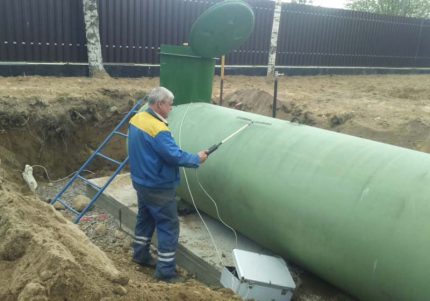
Comparison of fuel and equipment
Let's make a comparison of pellets and gas tanks for clarity.In a comparative review, we take the following data as a basis. For heating an area of 10 m2 with a ceiling height of 3 m, 1 kW of energy is needed. Additionally, you can consider the margin of 15-20%, which will be used for heating water.
The average operating time of boiler equipment is 10 hours / day. The duration of the heating season in central Russia is 7-8 months. in a year. The rest of the time the boiler is used to heat water and maintain the minimum temperature in the rooms at 8 degrees.
Criterion # 1 - fuel efficiency by efficiency
1 kg of pellets is equivalent to 1.6 kg of firewood and emits 5 kW of energy during combustion. If the area of the house is 100 m2, 10 kW per hour is needed, i.e. 2 kg of pellets.
The average efficiency of such fuel ranges from 50-90%. Efficiency depends on the heat loss of the building, the quality of pellets and other factors. These are the lowest rates when compared with electricity and gas.
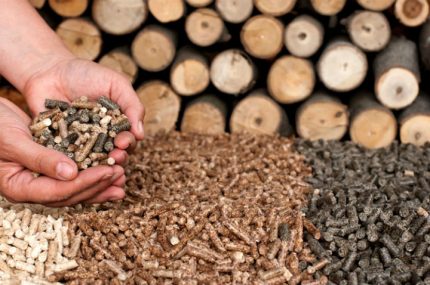
Another nuance is the variety of pellets. They are white, industrial and agro. The former have low ash content; when using them, the boiler requires cleaning once a month. Agro is made from sunflower, buckwheat, they are the most "dirty", but cheaper than the rest.
Comparison of pellets from different raw materials
| Fuel | Lower calorific value, kW / kg | Ash content,% |
| Wood chips | 3,9 | ≤3 |
| Straw pellets | 4,18–4,68 | 4,4–7,0 |
| Wood Pellets | 4,7 | ≤2 |
| Pellets with composition: 70% - straw; 30% - wood. | 4,32–4,67 | <5,11 |
| Agropellets | ≥4 | <6,0 |
| Corn cobs | 3,6 | 1,0–3,0 |
Why does it matter? The choice of boiler, efficiency and fuel cost depend on the availability of a particular type of pellet. White granules are expensive, but they have the highest calorific value.
And here liquefied gas shows stable 97%. Fuel is supplied evenly, the process is fully automated. The system does not depend on network fluctuations, pipeline accidents, gas quality is almost always high. 1 kg of liquefied gas produces 12.8 kW of energy.
Criterion # 2 - the cost of heating per season
A ton of pellets is sold at a price of 8-9 thousand rubles. Take the average - 8.5 thousand rubles.
For the heating season of 8 months. we get the following numbers:
- losses - 28,224 kW / h;
- fuel consumption - 5644 kg;
- amount - 48 thousand rubles.
Add the cost of delivery - from 7 thousand rubles. For the removal of waste will need to pay from 5 thousand rubles. We get 60 thousand rubles. for the heating season. If you need the services of a stoker, this will entail additional costs in the amount of 10 thousand rubles. per month.
One liter of LPG (liquefied gas) costs 18-20 rubles. already with delivery. On 1 m2 area leaves an average of 27 liters per season. That is, the gas tank volume of 2700 liters should be enough for the entire heating period. Is this really so?
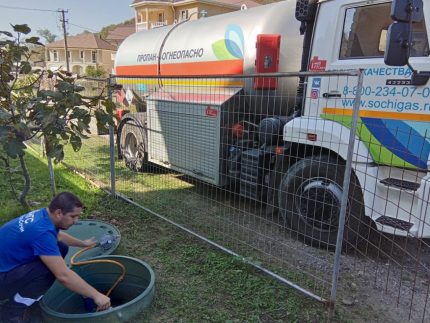
The total cost of LPG is 49-54 thousand rubles. in year. We talked about gas consumption from a gas tank in more detail in next article/
So what is cheaper to heat - gas or pellets? At a price gas is a little more expensive, but pellets require additional effort and expense.
Criterion # 3 - the cost of pellet and gas boilers
We will deal with the cost of equipment. The spread in prices of a pellet boiler is large: from 40 to 100 thousand rubles. and higher.
You can include in the system a conventional solid fuel boiler, potbelly stove or buleryan. But such designs need a grate upgrade.
There are several ways to reduce cracks so that granules do not fall out:
- replace the grate;
- lay a wire mesh on top or bottom;
- insert overlays.
Pellets will burn under such conditions, but in the absence of constant forced air exchange and maximum supply, some of the pellets can literally fly out into the pipe due to natural draft.
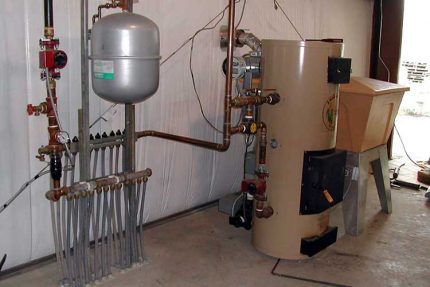
And still need delivery, installation and connectionas well as debugging a pellet boiler. All this will cost another 23-25 thousand rubles. Total we get the average value in the range of 175 thousand rubles. But you also need to equip a room for storing pellets - fuel supplies take up quite a bit of space.
More pluses and minuses of heating with a pellet boiler, as well as recommendations for its choice, we have given in our other article: Pellet heating boilers: types, advantages and rules for choosing the best boiler
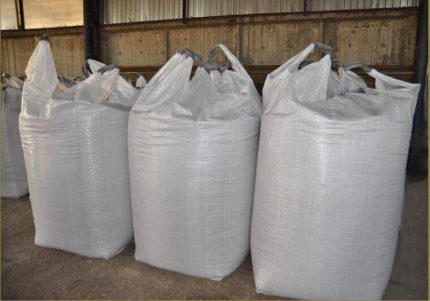
For house maintenance in 100 m2 enough gas tank with a capacity of 2700 liters. The price of the tank is 155-165 thousand rubles. Plus costgas boiler - from 40 thousand rubles. We get approximately 260 thousand rubles.
Earthwork, gas tank installation, delivery and other organizational work will cost another 60-70 thousand rubles.
Criterion # 4 - ease of use of systems
Pellet heating implies the presence in the household of a person who will search for fuel, store it, load it, monitor the combustion process, clean the boiler, and remove waste.
Some of the actions can be automated if you select a boiler with automatic feed and the ability to schedule a fuel supply schedule. Then the pellet can be loaded once a week, but this will entail additional equipment costs.
1 ton of pellets, depending on the ash content, gives about 5 kg of waste. Even a boiler with good automation does not completely eliminate the need to clean it. Plus, in addition to buying the appropriate equipment, you will need electricity to service the system.
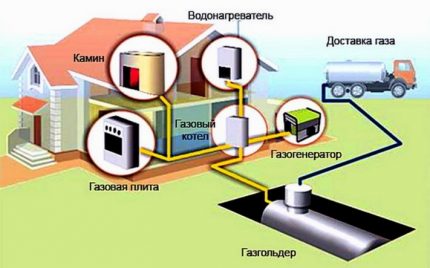
The gas tank is refilled 1-2 times a year, the process takes a couple of hours, then the system works independently. LPG does not need to be loaded, it moves through the pipes itself and gives heat.
The tank is located underground and does not take up space; it does not need a separate storage room.
But the gas holder requires inspection twice a year: in spring, in autumn. If necessary, cosmetic repairs are carried out.
Often the companies that are installing the tanks offer free equipment maintenance for the first year. Then a contract for 12 months is concluded. with a monthly fee of 12-13 thousand rubles, which includes an emergency exit. One-time maintenance costs 3.5-4 thousand rubles.
To see a detailed analysis of the pros and cons of heating with a gas tank, please go this link.
Criterion # 5 - Reliability and Security
Solid fuel and pellet boilers are reliable under two conditions: there are fuel reserves and the person serving the system. Plus, in the absence of pellets, such equipment can be loaded with other solid fuels: firewood, coal.
There is no doubt in reliability and gas tank. Evaporation of gas occurs even at the lowest temperatures. The human factor does not affect the process.
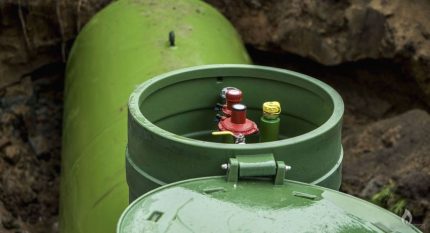
Regarding safety, when using a solid fuel or pellet boiler, there is a risk of carbon monoxide poisoning. When the boiler room is located in the house, you need to be prepared to respond to smoke at any time: open windows, doors, reconfigure equipment.Therefore, it is advisable to put together with the installation of the boiler immediately and carbon monoxide sensor.
LPG is safe when stored properly. In the event of a leak, liquid gas goes into the ground, because it weighs more air.
Leakage is possible when operating an old tank with worn seams. Plus it is important to comply with the installation gas tank placement rule far from stray currents and heating mains (SP 62.13330.2011).
But in the room where gas-using equipment is installed, gas leakage can occur for various reasons - breakdown of the boiler, stove, leakage of the connections, etc. To detect it in time, it is advisable to establish gas leak sensor.
Summary comparison table
The above calculations are relevant for a house at 100 m2. Costs do not reflect all the options, the real climate is affected by the region’s climate, the severity of winter, and the level of thermal insulation of the house.
| Parameters | Pellets | LPG (gas holder) |
| Efficiency | 50-90% | 97% |
| Fuel cost | 48 thousand rubles in year | 49-54 thousand rubles in year |
| Cost of equipment | from 40 thousand rubles | from 155 thousand rubles plus gas boiler |
| Connection | Boiler installation | Installation of a gas tank on the site and a boiler in the house |
| Ease of operation | Regular fuel loads are needed daily or once a week. The quality of the pellets is important. | Full autonomy after refueling 1-2 times a year. |
| Reliability | High | High, problems can arise only if the wrong choice and installation |
| Safety | Carbon monoxide hazard | High, no risk |
| Electricity addiction | Yes | No |
| Fuel warehouse | Need | Not needed |
| Service | Loading, cleaning | Tank refueling, inspection twice a year |
A bunch of gas holder plus a gas boiler provides ease of use, a certain independence from external factors (electricity, quality of pellet production). But it implies the availability of free space on a site far from residential premises and the implementation of such a project will cost more than a "competitor".
Pellet equipment is cheaper, as is the fuel itself. But it requires high quality pellets, ongoing maintenance or additional costs for modernization. At the same time, it gives low efficiency, when compared with a gas holder. But a gas boiler also requires annual maintenance.
We also recommend that you familiarize yourself with the comparison between each other gas tank and main gas.
Conclusions and useful video on the topic
Operating experience of a pellet boiler Zota Pellet 15s with remote control worth 165 thousand rubles.
Installing a gas tank with some nuances and connecting equipment to it.
Part 1:
Part 2:
Choosing what to install - a pellet boiler or gas holder, consider all factors of economic benefit and operating conditions.
The amount for the purchase of equipment, its installation, connection refers to one-time costs. The cost of fuel and the operation of equipment are already fixed costs, and they are the ones that hit the family budget the most.
What kind of fuel do you use? Share your experience with other users - the feedback form is located below.
If you still have questions about the topic of the article, ask our experts and visitors to our site in the comments section.

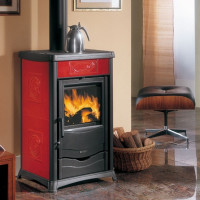 Autonomous gas heating of a private house: device options and an overview of the best solutions
Autonomous gas heating of a private house: device options and an overview of the best solutions 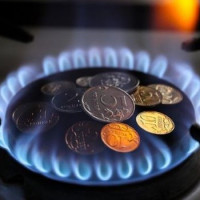 How to save gas when heating a private house: an overview of the best ways to save gas
How to save gas when heating a private house: an overview of the best ways to save gas 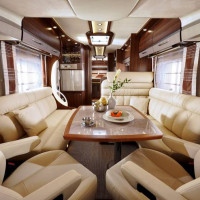 Heating systems in caravans: heater options for a comfortable temperature in the camper
Heating systems in caravans: heater options for a comfortable temperature in the camper 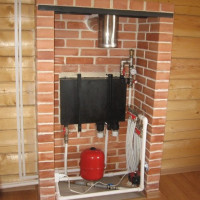 How to arrange heating a private house without gas: the organization of the system in a wooden building
How to arrange heating a private house without gas: the organization of the system in a wooden building 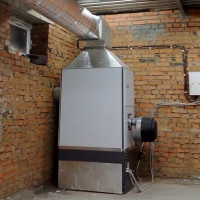 Gas heat generators for air heating: types and specifics of gas equipment
Gas heat generators for air heating: types and specifics of gas equipment 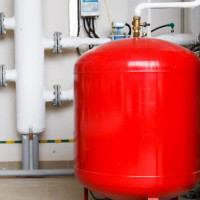 Pressure in the expansion tank of a gas boiler: norms + how to pump and adjust
Pressure in the expansion tank of a gas boiler: norms + how to pump and adjust  How much does it cost to connect gas to a private house: the price of organizing gas supply
How much does it cost to connect gas to a private house: the price of organizing gas supply  The best washing machines with dryer: model rating and customer tips
The best washing machines with dryer: model rating and customer tips  What is the color temperature of light and the nuances of choosing the temperature of the lamps to suit your needs
What is the color temperature of light and the nuances of choosing the temperature of the lamps to suit your needs  Replacement of a geyser in an apartment: replacement paperwork + basic norms and requirements
Replacement of a geyser in an apartment: replacement paperwork + basic norms and requirements